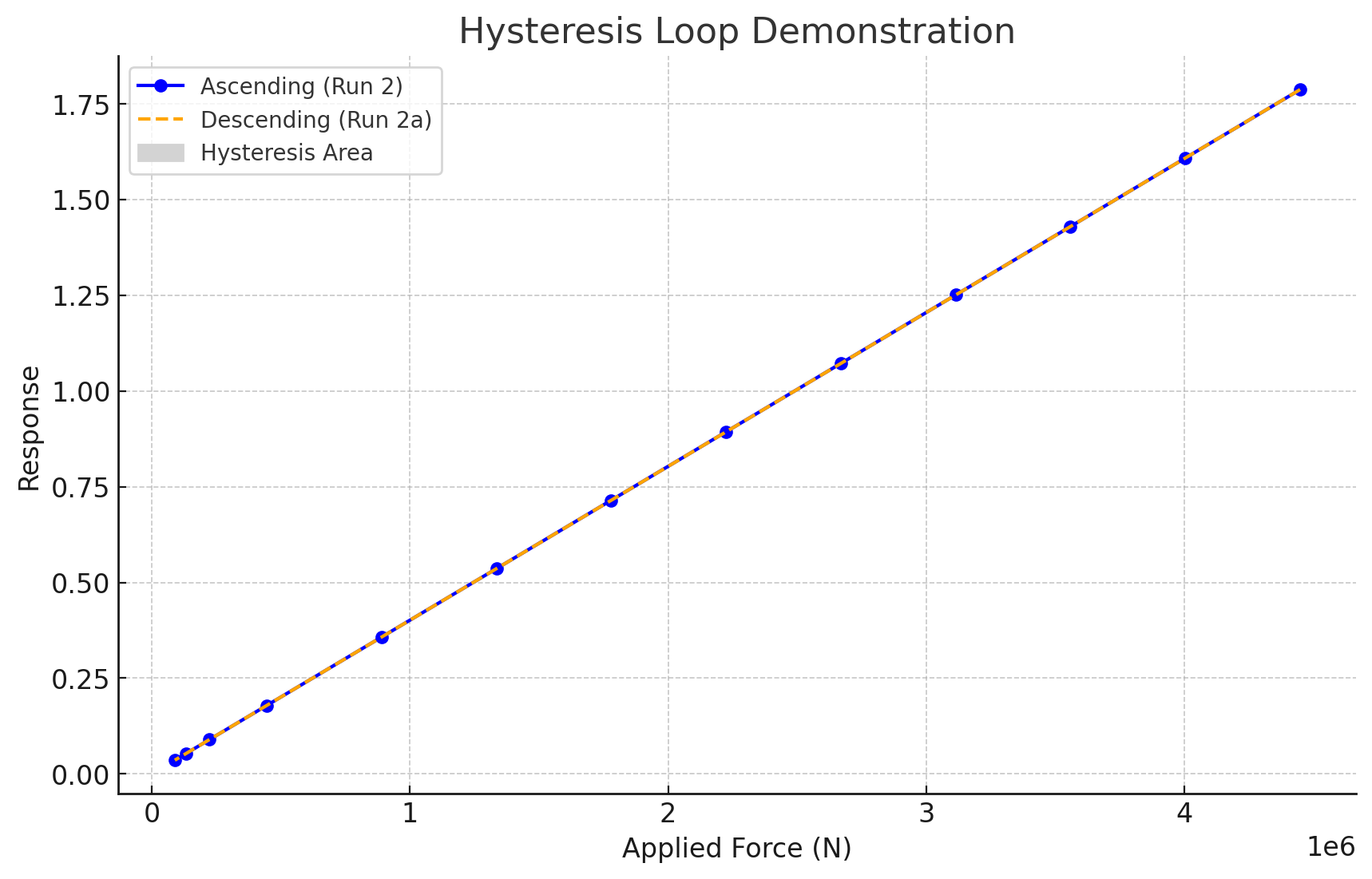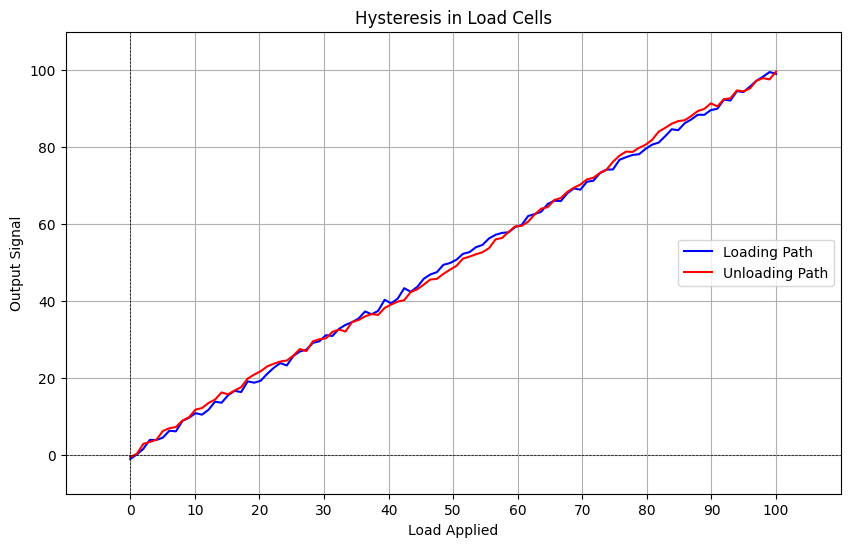What is Hysteresis?

Almost any load cell specification sheet has a term called Hysteresis.
This particular article hopes to explain what the term load cell hysteresis is.
Load Cell Accuracy: Simple Definition
In a simplistic sense, hysteresis is a way to measure how well a load cell returns to its starting point when force is applied and then removed.
It tells us how much the output changes when we apply a force in one direction (like pushing down) and then in the opposite direction (like releasing it).
Load Cell Accuracy: Real Definition of Hysteresis

Hysteresis, % R.O.: Hysteresis measures the difference in output between ascending and descending values.
It reflects the load cell’s ability to return to its initial state. Lower hysteresis values (as low as ±0.02 %) indicate less error and better accuracy.
For force measurements, Hysteresis is defined as the difference between two responses of a single given load, one ascending from the lowest non-zero load applied, the other descending from the full-scale load.
Hysteresis is typically calculated near 50 % load.
To calculate Hysteresis, two responses must be recorded for the same load applied.
Following the below equation, the full-scale response should be subtracted from the ascending load's response.
The difference should be divided by the descending load's response.
To ensure Hysteresis is a positive value, the absolute value of the quotient is used.
Calculation
Hysteresis = | (Ascending(response) - Descending(response)) / FullScale (response) |
More Information on Ascending (Increasing) versus Descending (Decreasing) measurements
Errors from Hysteresis can be high enough that if a load cell is used to make descending measurements, then it must be calibrated with a descending range.
That range is only valid if the load cell is loading to the highest force point in the range before descending measurements are made.
The difference in output on an ascending curve versus a descending curve can be significant.
For example, an exceptionally good Morehouse 100K precision shear-web load cell had an output of -2.03040 on the ascending curve and -2.03126 on the descending curve. Using the ascending-only curve would result in an additional error of 0.042 %.
At Morehouse, our calibration lab sampled several instruments and recorded the following differences.

Load cells from five different manufacturers were sampled, and the results were recorded.
The differences between the ascending and descending points varied from 0.007 % (shear web type cell) to 0.120 % on a column type cell. On average, the difference was approximately 0.06 %. Six of the seven tests were performed using deadweight primary standards at Morehouse, which are accurate within 0.002 % of the applied force.
Load Cell Accuracy: What is Hysteresis? - Conclusion
Hysteresis measures how well a load cell returns to its starting point after a force is applied and then removed.
Lower hysteresis values indicate that the load cell's response under increasing forces is more similar to the same forces when the load is being removed (loading and unloading).
The differences between ascending and descending measurements can be significant, sometimes resulting in errors if not properly accounted for.
As demonstrated by the examples from Morehouse's calibration lab, hysteresis can vary between different types of load cells and even among those from various manufacturers.
These differences highlight the importance of proper calibration, especially when descending measurements are required.
By being aware of hysteresis and its effects, users can ensure that their load cells are calibrated correctly for their specific applications.
This attention to detail helps in achieving more accurate measurements.
Want to know more about everything on our load cell specification sheet? Please read our full article here.
Further Notes:

Some might critique the graph in the beginning. That graph showed the concept and the distinction between ascending and descending measurements.
When we plot the actual graph for our 1,000, 000 lbf standard, the lines cannot be distinguished for the scale we are using even when zoomed in.
The shaded area between the ascending and descending curves represents the hysteresis, though since the numbers are so small, around 0.015 % at the 50 % point.

Another way to demonstrate the concept is with loading and unloading paths. The load cell or load cells on a scale will likely show a different result when loading than when unloading.
The graph demonstrates two distinct paths:
- A blue line representing the loading path (increasing load from 0 to 100)
- A red line representing the unloading path (decreasing load from 100 to 0)
More Information about Morehouse
We believe in changing how people think about force and torque calibration in everything we do.
This includes setting expectations and challenging the "just calibrate it" mentality by educating our customers on what matters and what may cause significant errors, such as not understanding what Hysteresis is.
We focus on reducing these errors and making our products simple and user-friendly.
This means your instruments will pass calibration more often and produce more precise measurements, giving you the confidence to focus on your business.
Companies around the globe rely on Morehouse for accuracy and speed.
Our measurement uncertainties are 10-50 times lower than the competition, providing you more accuracy and precision in force measurement.
We turn around your equipment in 7-10 business days so you can return to work quickly and save money.
When you choose Morehouse, you're not just paying for a calibration service or a load cell.
You're investing in peace of mind, knowing your equipment is calibrated accurately and on time.
Through Great People, Great Leaders, and Great Equipment, we empower organizations to make Better Measurements that enhance quality, reduce risk, and drive innovation.
With over a century of experience, we’re committed to raising industry standards, fostering collaboration, and delivering exceptional calibration solutions that build a safer, more accurate future.
Contact Morehouse at info@mhforce.com to learn more about our calibration services and load cell products.
Email us if you ever want to chat or have questions about a blog.
We love talking about this stuff. We have many more topics other than expressing SI units!
Our YouTube channel has videos on various force and torque calibration topics here.


